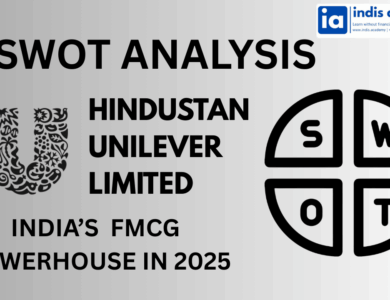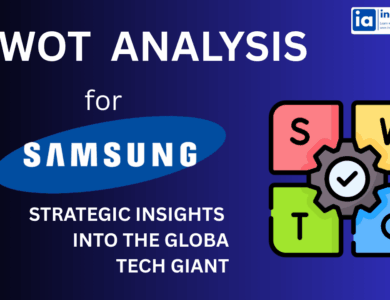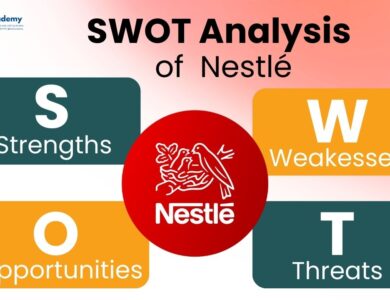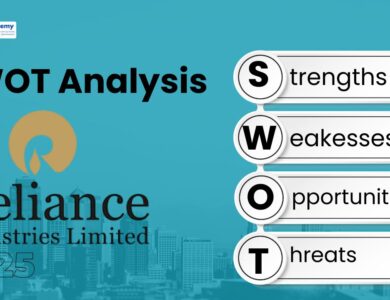Complete SWOT Analysis of Pepsi – Inside the Strategy of a Global Beverage Giant
"Explore PepsiCo's 2025 SWOT analysis—uncover strengths, weaknesses, opportunities, and threats shaping the global beverage giant's strategy."
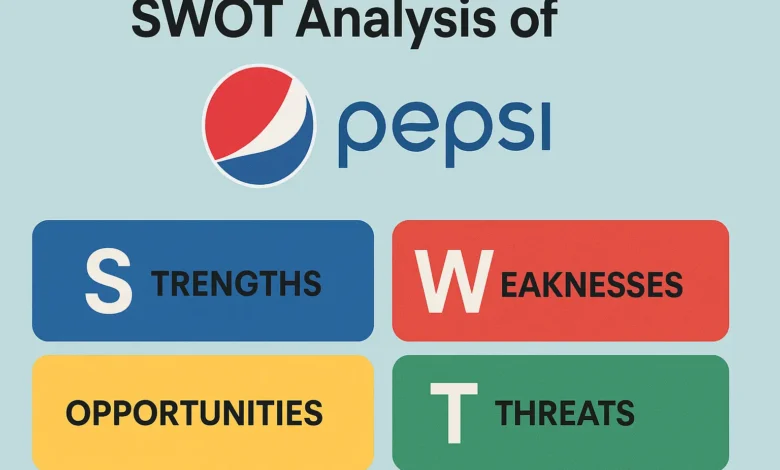
Pepsi is more than just a soda—it’s a cultural icon. From Super Bowl halftime shows to viral music campaigns, Pepsi has carved out a bold and youthful identity in the global beverage market.
Owned by PepsiCo, the brand has stood the test of time, remaining a strong challenger to Coca-Cola while expanding its footprint into new categories and markets.
But how does Pepsi stay relevant in an age where health-conscious consumers are moving away from sugary drinks? What are the brand’s biggest strengths, and where does it face real threats?
In this article, we’ll break down a complete SWOT analysis of Pepsi, exploring its Strengths, Weaknesses, Opportunities, and Threats in the ever-evolving global beverage industry. Whether you’re a business student, marketer, or just curious about how global brands operate, this breakdown will offer insights into Pepsi’s strategic playbook and its path forward in a highly competitive market.
Also Read: Complete SWOT Analysis of Zomato – How It Dominates the Food Delivery Market
Learn AI & Digital Marketing,
Pay Fees After Placement
- ✅ Minimal Admission Fees
- ✅ No Loan or Income Sharing Agreement
- ✅ 100% Placement Support
- ✅ ISO & Govt Registered Certificate
- ✅ Practical 3+1 Months Duration
Get a free counseling call. We’ll guide you through learning, certification, and job placement.
Request a Free Call Back
Takes less than a minute.
Company Overview – About Pepsi
Pepsi, the flagship soft drink of PepsiCo, was created in 1898 in North Carolina by pharmacist Caleb Bradham. Originally called “Brad’s Drink,” it was rebranded as Pepsi-Cola in 1903 and has since become one of the most recognized beverage brands in the world.
Today, PepsiCo is a global food and beverage leader, with operations in over 200 countries and annual revenues exceeding $80 billion.
Pepsi’s core products include Pepsi, Diet Pepsi, Pepsi Max, and Mountain Dew, alongside a growing line of health-conscious beverages, such as bubbly, LIFEWTR, and Gatorade Zero. Beyond soft drinks, the parent company PepsiCo owns popular snack brands like Lay’s, Doritos, Quaker, and Tropicana.
Known for its youth-oriented branding, celebrity endorsements, and vibrant global campaigns, Pepsi has consistently positioned itself at the intersection of pop culture and refreshment.
With fierce competition from Coca-Cola, the brand’s evolution hinges on innovation, market responsiveness, and a strong push toward sustainability and digital transformation.
What is SWOT Analysis?
A SWOT analysis is a strategic planning tool used to evaluate a brand or company’s position in the market by identifying four key dimensions:
- Strengths – Internal assets or advantages that give the company a competitive edge.
- Weaknesses – Internal limitations that hinder growth or performance.
- Opportunities – External factors that the company can capitalize on to grow or improve.
- Threats – External challenges that could negatively impact success.
For a global brand like Pepsi, conducting a SWOT analysis provides critical insights into how the company maintains relevance across decades, manages global competition, and adapts to changing consumer preferences—especially in a world shifting toward health-conscious, sustainable, and digitally connected lifestyles.
This analysis helps uncover where Pepsi thrives, where it lags behind, and what strategic moves could shape its future in the fast-moving beverage industry.
Also Read: Complete SWOT Analysis of Mahindra – How the Brand Continues to Lead the Indian Market
Pepsi’s Strengths
Pepsi is one of the most recognized and valuable beverage brands in the world. Its global reach, diversified portfolio, and aggressive marketing tactics have helped it maintain a strong position in the face of evolving consumer demands. Let’s look at the core strengths that fuel Pepsi’s success:
1. Global Brand Recognition
Pepsi enjoys massive brand equity, with its iconic red, white, and blue logo recognized in over 200 countries. Decades of memorable advertising campaigns, celebrity endorsements, and event sponsorships have made Pepsi a household name across generations.
2. Diverse Product Portfolio
While Pepsi is known for its flagship cola, its parent company PepsiCo owns a wide range of beverage and snack brands—Mountain Dew, 7UP, Gatorade, Tropicana, Lipton (via JV), Lay’s, Quaker, and more. This diversification allows the brand to capture a broader market, reduce risk, and cross-sell products globally.
3. Powerful Marketing & Sponsorships
Pepsi’s marketing strength lies in its deep connection with pop culture. From Super Bowl halftime shows to partnerships with Beyoncé, Bad Bunny, and Doja Cat, Pepsi constantly aligns with youth trends. The brand’s campaigns are bold, emotional, and built for viral reach.
4. Robust Global Distribution Network
PepsiCo’s vast distribution system ensures its products are available almost everywhere—from local grocery shops to global fast-food chains like KFC, Pizza Hut, and Burger King. This scale and consistency provide a major competitive advantage.
5. Product Innovation & Flavor Variants
Pepsi regularly experiments with limited editions and health-focused innovations like Pepsi Zero Sugar, Nitro Pepsi, and Pepsi Café. This keeps the brand relevant and gives it a modern, risk-taking image.
6. Youth-Oriented Positioning
Pepsi’s tagline “For the Love of It” reflects its long-standing connection with younger demographics. Through music, fashion, gaming, and influencer-driven content, Pepsi has cultivated a brand image that’s fun, energetic, and future-facing.
Also Read: Sony SWOT Analysis: Key Business Strategies & Market Challenges
Pepsi’s Weaknesses
Despite being one of the top players in the global beverage industry, Pepsi faces several internal challenges that could impact its market performance and long-term sustainability. These weaknesses highlight areas where the brand must improve to stay competitive.
1. Heavy Dependence on Carbonated Drinks
Pepsi still earns a significant portion of its revenue from carbonated soft drinks (CSDs)—a category that is declining globally due to growing health awareness. Even with diversification, its flagship product remains cola, which ties the brand to a category under increasing pressure.
2. Negative Health Perception
Pepsi products are often viewed as high in sugar, caffeine, and artificial ingredients, which can alienate health-conscious consumers. Despite offering low-calorie versions, the overall brand still struggles with a “junk food” image, especially among older or wellness-focused demographics.
3. Lower Market Share Compared to Coca-Cola
While Pepsi is a major global player, it consistently lags behind Coca-Cola in overall soft drink market share. Coca-Cola dominates in many international markets, and Pepsi has struggled to close the gap, particularly in developing economies.
4. Product Failures and Inconsistencies
Pepsi has launched several product variants and innovations that failed to gain traction—Crystal Pepsi, Pepsi AM, and Pepsi Blue, for example. These missteps dilute brand focus and occasionally lead to wasted marketing spend and shelf space.
5. Environmental Impact Criticism
PepsiCo has faced ongoing scrutiny for its use of plastic packaging, water usage in manufacturing, and carbon emissions. Environmental groups and regulators continue to pressure the company to become more sustainable, and delays or missteps in these areas can harm its public image.
These weaknesses underscore the importance of strategic reinvention, health-conscious innovation, and brand clarity if Pepsi wants to retain its leadership in the beverage space and grow sustainably.
Also Read: Royal Enfield SWOT Breakdown: How the Brand Dominates the Mid-Size Bike Market
Pepsi’s Opportunities
With changing consumer lifestyles, advancing technology, and rising global demand for healthier alternatives, Pepsi has multiple avenues to expand and strengthen its brand. Capitalizing on these opportunities could help it not only retain market share but also win over new generations of consumers.
1. Health-Conscious Product Expansion
As more consumers shift toward low-sugar, organic, and functional beverages, Pepsi can scale its offerings in these segments. The success of Pepsi Zero Sugar, bubbly (sparkling water), and Gatorade Zero shows strong demand for healthier choices.
There’s potential for growth in plant-based drinks, vitamin-infused waters, and kombucha-style beverages.
2. Growth in Emerging Markets
Pepsi has a solid presence in North America and Europe, but emerging economies like India, Indonesia, Brazil, and Africa offer untapped demand.
With growing urban populations, increasing disposable income, and evolving retail infrastructure, Pepsi can expand distribution, launch localized flavors, and increase brand loyalty in these regions.
3. Direct-to-Consumer (D2C) & E-commerce Growth
The rise of online grocery shopping and quick commerce platforms offers Pepsi the chance to deepen its D2C relationships. By enhancing its digital storefronts, launching subscription models, and partnering with platforms like Amazon, Instacart, or local delivery startups, Pepsi can stay closer to its end consumers and collect valuable buying behavior data.
4. Sustainability-Driven Innovation
PepsiCo has already begun investing in eco-friendly packaging, water stewardship, and carbon reduction through its “pep+ (PepsiCo Positive)” initiative.
Scaling these efforts further—like developing biodegradable bottles, reusable packaging, or cleaner manufacturing processes—can strengthen its appeal to eco-conscious consumers and improve regulatory compliance.
5. Tech-Enabled Personalization & Marketing
With AI, AR/VR, and advanced consumer analytics, Pepsi has the chance to create more personalized experiences—from custom packaging to location-based campaigns and AI-powered flavor creation. This digital transformation could help deepen brand loyalty, especially among Gen Z and Millennial audiences.
By embracing these opportunities, Pepsi can future-proof its business and position itself as a modern, innovative, and responsible beverage brand—ready to lead in a rapidly changing consumer landscape.
Pepsi’s Threats
Operating in a fast-moving and highly competitive industry, Pepsi faces numerous external challenges that could affect its market share, profitability, and brand image. Let’s take a look at the major threats that Pepsi must continuously navigate:
1. Rising Health Awareness & Anti-Sugar Movement
With increasing global focus on healthy lifestyles, more consumers are avoiding sugary sodas and opting for low-calorie, organic, or functional beverages. This trend directly impacts Pepsi’s flagship cola products and puts pressure on its traditional business model.
2. Regulatory Challenges
Governments worldwide are implementing sugar taxes, labeling restrictions, and advertising bans, especially targeting sugary drinks and junk food. These policies not only affect Pepsi’s marketing and pricing power but may also lead to declining consumption in regulated regions.
3. Intense Market Competition
Pepsi competes directly with Coca-Cola, which has a stronger market presence in several key markets. Beyond that, brands like Red Bull, Nestlé, and local beverage startups are aggressively capturing niche segments like energy drinks, plant-based beverages, and premium hydration.
4. Supply Chain Disruptions
Global events like pandemics, geopolitical tensions, and raw material shortages can disrupt Pepsi’s manufacturing and distribution networks. This may lead to increased operational costs, inventory delays, and inconsistent availability, especially in emerging markets.
5. Environmental and Social Activism
Pepsi continues to face criticism from environmental groups for its use of plastic packaging, water usage in bottling plants, and carbon emissions. Failure to meet ESG (Environmental, Social & Governance) expectations could result in reputational damage, consumer backlash, or even legal challenges in eco-sensitive regions.
6. Shifting Consumer Preferences & Brand Fatigue
With younger consumers prioritizing authenticity, minimalism, and natural ingredients, Pepsi’s long-established image may struggle to resonate if not refreshed regularly. If the brand fails to evolve with generational values, it risks being perceived as outdated.
These threats highlight the need for Pepsi to stay adaptive, innovative, and socially responsible. Only by addressing these risks head-on can the brand secure its position in a market that’s evolving faster than ever.
Pepsi’s Competitive Strategy
To thrive in an industry dominated by strong rivals and evolving consumer expectations, Pepsi has developed a multi-faceted competitive strategy that blends brand reinvention, diversification, and cultural alignment. Here’s how Pepsi stays in the game:
1. Brand Reinvention & Visual Identity
Pepsi continually refreshes its branding to stay modern and culturally connected. Its latest logo redesign (2023) is bold, digital-friendly, and speaks directly to younger audiences. These frequent identity upgrades help keep the brand visually fresh and digitally adaptable in a crowded market.
2. Pop Culture & Entertainment Partnerships
Pepsi has built strong emotional connections through music, sports, and entertainment. From sponsoring the NFL Super Bowl Halftime Show to campaigns featuring Doja Cat, Beyoncé, and Bad Bunny, Pepsi stays front-of-mind among youth and trend-driven consumers.
3. Diversification Beyond Cola
Pepsi’s parent company, PepsiCo, has aggressively expanded into non-carbonated beverages, health drinks, energy beverages (Rockstar), and snacks. This diversification reduces risk and aligns with evolving consumption trends—like fitness, hydration, and wellness.
4. Digital Engagement & Personalization
Pepsi is focusing on data-driven marketing through social listening, influencer campaigns, AR filters, and interactive content. The brand is also investing in D2C platforms and subscription models, giving consumers a seamless experience online and offline.
5. Sustainability-Led Transformation
Through the pep+ (PepsiCo Positive) initiative, Pepsi aims to become net water positive, cut greenhouse gas emissions, and use 100% recyclable packaging by 2030. These goals reflect a serious shift toward sustainability, helping the brand appeal to eco-conscious consumers and align with global ESG standards.
Pepsi’s competitive strategy hinges on staying cool, inclusive, and future-ready—balancing heritage with innovation, and emotion with ethics. It’s this adaptability that helps Pepsi compete head-to-head with Coca-Cola while carving its own unique identity in a shifting marketplace.
Conclusion & Final Thoughts
Pepsi stands as one of the most iconic and influential beverage brands in the world. Its youthful energy, pop culture presence, and bold marketing have helped it remain a key player in the global soft drink industry for decades. Through its diverse product portfolio, strong distribution network, and continuous brand reinvention, Pepsi has shown resilience in the face of changing consumer tastes and intensifying competition.
However, Pepsi also faces real challenges—ranging from health concerns and sugar regulations to environmental scrutiny and market saturation. To stay ahead, the brand must focus on expanding its health-conscious offerings, strengthening its sustainability practices, and engaging consumers through personalized digital experiences.
As this SWOT analysis reveals, Pepsi’s ability to innovate, adapt, and connect with global audiences will define its future. With the right strategies in place, Pepsi is well-positioned to continue shaping the next wave of the beverage and lifestyle industry.
